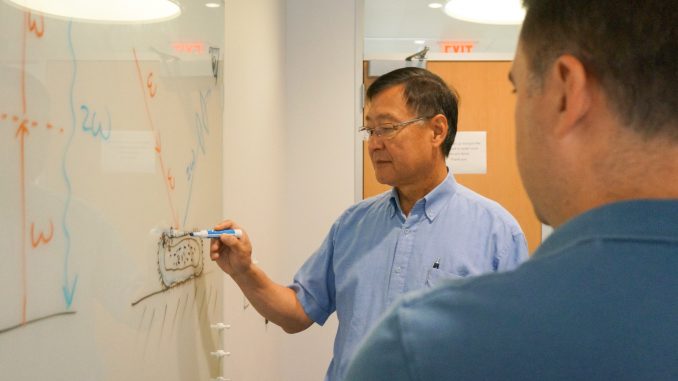
The first microscope invented in 1590 opened up a world of scientific exploration. Now, two professors are taking the technology to the next level with a National Science Foundation grant worth more than $1 million.
Chemistry professor Eric Borguet will use the three-year grant to build an advanced nonlinear optical microscope, which will allow researchers to see molecules close up in ways they never have. Borguet leads the project with Hai-Lung Dai, a Laura H. Carnell professor of chemistry and vice president of the Office of International Affairs. They received the grant on Monday.
“We both had worked hard on this,” Borguet said. “We and a number of people in our group, graduate students and senior personnel, were very keen on this for a variety of reasons.”
Borguet, Dai and their post-doctoral researchers, doctorate and undergraduate students will spend the next year and a half constructing the microscope. Borguet and Dai each run individual research labs, but the two labs will collaborate on the microscope project. Ph.D. students will help build the microscope and conduct research as part of their theses.
Borguet is also a deputy director of Temple’s Center for the Computational Design of Functional Layered Materials, a research center funded by the United States Department of Energy. His research examines the boundaries between different materials, like solids and liquids.
These boundaries, often called interfaces, can only be seen using very specific microscopes – like the one Borguet’s team will use the grant to build. Borguet’s lab focuses on examining the physical and chemical processes that happen on the materials’ surfaces and interfaces.
“We are interested in understanding how charge develops on a surface, why certain ions stick to surfaces, understanding how water is structured at those surfaces,” Borguet said.
Dai’s laboratory focuses on the same types of boundaries, but between biological cells instead of types of matter. He examines how molecules get transported in and out of biological cells at their membranes.
Borguet said most microscopes cannot clearly see different parts of a biological cell, like what’s on the inside versus what’s on the outside.
“The membrane is really too thin,” he added. “It’s essentially more than 1,000 times thinner than the size of the cell.”
By using nonlinear optics, Dai said he and Borguet can look at molecules moving in and out of cells and examine those molecules at the cell’s surface.
“If you develop a drug, [you need to know] whether the drug can go to the target cell and enter that cell,” Dai said. “[We can look at] efficiency of uptake and applications of understanding the pharmacology.”
The NSF is a federal funding agency that supports approximately 24 percent of federally funded academic research in the United States. The three-year grant is the only award worth more than $1 million that was given in NSF’s chemistry division this year, Borguet said.
“It’s a validation of the work that Dr. Dai and I have done,” he added. “These are peer-reviewed grants, which means that our peers have acknowledged that we’ve done a good job in the past.”
NSF grants are highly competitive, as is most research funding. Borguet said only about 20 percent of applicants succeed in getting grants of this caliber. In 2017, about 23 percent of NSF grant proposals succeeded in securing funding.
The microscope project includes several other faculty members who hope to benefit from the technology, including assistant physics professor Darius Torchinsky. Torchinsky is a physicist who examines the electronic properties of different materials.
Torchinsky can use the microscope’s nonlinear optics to better understand how electrons in these materials function.
“With these topological materials, some of them don’t even have a linear response to light,” Torchinsky said. “You need to probe them…to see what is characteristic about them from an electromagnetic point of view.”
For Temple, this grant has the potential to improve the university’s research reputation. Torchinsky said Temple can get lost among top research institutions on the East Coast, like Penn and Princeton University.
But Torchinsky also believes the university can compete with the other institutions, and this NSF grant will help.
“Temple really punches above its weight in terms of the research that’s going on here,” Torchinsky said. “For sure it will help raise the profile.”



Be the first to comment